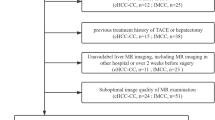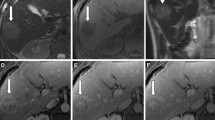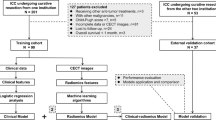Abstract
Objective
To differentiate combined hepatocellular cholangiocarcinoma (cHCC-CC) from cholangiocarcinoma (CC) and hepatocellular carcinoma (HCC) using machine learning on MRI and CT radiomics features.
Methods
This retrospective study included 85 patients aged 32 to 86 years with 86 histopathology-proven liver cancers: 24 cHCC-CC, 24 CC, and 38 HCC who had MRI and CT between 2004 and 2018. Initial CT reports and morphological evaluation of MRI features were used to assess the performance of radiologists read. Following tumor segmentation, 1419 radiomics features were extracted using PyRadiomics library and reduced to 20 principle components by principal component analysis. Support vector machine classifier was utilized to evaluate MRI and CT radiomics features for the prediction of cHCC-CC vs. non-cHCC-CC and HCC vs. non-HCC. Histopathology was the reference standard for all tumors.
Results
Radiomics MRI features demonstrated the best performance for differentiation of cHCC-CC from non-cHCC-CC with the highest AUC of 0.77 (SD 0.19) while CT was of limited value. Contrast-enhanced MRI phases and pre-contrast and portal-phase CT showed excellent performance for the differentiation of HCC from non-HCC (AUC of 0.79 (SD 0.07) to 0.81 (SD 0.13) for MRI and AUC of 0.81 (SD 0.06) and 0.71 (SD 0.15) for CT phases, respectively). The misdiagnosis of cHCC-CC as HCC or CC using radiologists read was 69% for CT and 58% for MRI.
Conclusions
Our results demonstrate promising predictive performance of MRI and CT radiomics features using machine learning analysis for differentiation of cHCC-CC from HCC and CC with potential implications for treatment decisions.
Key Points
• Retrospective study demonstrated promising predictive performance of MRI radiomics features in the differentiation of cHCC-CC from HCC and CC and of CT radiomics features in the differentiation of HCC from cHCC-CC and CC.
• With future validation, radiomics analysis has the potential to inform current clinical practice for the pre-operative diagnosis of cHCC-CC and to enable optimal treatment decisions regards liver resection and transplantation.





Similar content being viewed by others
Abbreviations
- AUC:
-
Area under the curve
- CC:
-
Cholangiocarcinoma
- cHCC-CC:
-
Combined hepatocellular cholangiocarcinoma
- DWI:
-
Diffusion-weighted image
- HBP:
-
Hepatobiliary phase
- HCC:
-
Hepatocellular carcinoma
- ML:
-
Machine learning
- PCA:
-
Principal component analysis
- RBF:
-
Radial basis function
- ROC:
-
Receiver operating characteristic curve
- ROI:
-
Region of interest
- SD:
-
Standard deviation
- SVM:
-
Support vector machine
References
Gera S, Ettel M, Acosta-Gonzalez G, Xu R (2017) Clinical features, histology, and histogenesis of combined hepatocellular-cholangiocarcinoma. World J Hepatol 9(6):300–309
WHO Classification of Tumours Editorial Board (2019) WHO Classification of Tumours, digestive system tumours. 5th ed. WHO Publications 1: 260–262
Stavraka C, Rush H, Ross P (2019) Combined hepatocellular cholangiocarcinoma (cHCC-CC): an update of genetics, molecular biology, and therapeutic interventions. J Hepatocell Carcinoma 6:11–21
Zhang F, Chen XP, Zhang W et al (2008) Combined hepatocellular cholangiocarcinoma originating from hepatic progenitor cells: immunohistochemical and double-fluorescence immunostaining evidence. Histopathology 52(2):224–232
Kim H, Park C, Han KH et al (2004) Primary liver carcinoma of intermediate (hepatocyte-cholangiocyte) phenotype. J Hepatol 40(2):298–304
Garancini M, Goffredo P, Pagni F et al (2014) Combined hepatocellular-cholangiocarcinoma: a population-level analysis of an uncommon primary liver tumor. Liver Transpl 20(8):952–959
Magistri P, Tarantino G, Serra V, Guidetti C, Ballarin R, Di Benedetto F (2017) Liver transplantation and combined hepatocellular-cholangiocarcinoma: feasibility and outcomes. Dig Liver Dis 49(5):467–470
Bridgewater J, Galle PR, Khan SA et al (2014) Guidelines for the diagnosis and management of intrahepatic cholangiocarcinoma. J Hepatol 60:1268–1289
Marrero JA, Kulik LM, Sirlin CB et al (2018) Diagnosis, staging, and management of hepatocellular carcinoma: 2018 practice guidance by the American Association for the Study of Liver Diseases. Hepatology 68(2):723–750
Li DB, Si XY, Wang SJ, Zhou YM (2019) Long-term outcomes of combined hepatocellular-cholangiocarcinoma after hepatectomy or liver transplantation: a systematic review and meta-analysis. Hepatobiliary Pancreat Dis Int 18(1):12–18
Sammon J, Fisher S, Menezes R et al (2018) MRI features of combined hepatocellular- cholangiocarcinoma versus mass forming intrahepatic cholangiocarcinoma. Cancer Imaging 18(1):8
Shetty AS, Fowler KJ, Brunt EM, Agarwal S, Narra VR, Menias CO (2014) Combined hepatocellular-cholangiocarcinoma: what the radiologist needs to know about biphenotypic liver carcinoma. Abdom Imaging 39(2):310–322
Kassahun WT, Hauss J (2008) Management of combined hepatocellular and cholangiocarcinoma. Int J Clin Pract 62(8):1271–1278
Chi CT, Chau GY, Lee RC et al (2020) Radiological features and outcomes of combined hepatocellular-cholangiocarcinoma in patients undergoing surgical resection. J Formos Med Assoc 119(1 Pt 1):125–133
Fowler KJ, Sheybani A, Parker RA 3rd et al (2013) Combined hepatocellular and cholangiocarcinoma (biphenotypic) tumors: imaging features and diagnostic accuracy of contrast-enhanced CT and MRI. AJR Am J Roentgenol 201:332–339
Nishie A, Yoshimitsu K, Asayama Y et al (2005) Detection of combined hepatocellular and cholangiocarcinomas on enhanced CT: comparison with histologic findings. AJR Am J Roentgenol 184(4):1157–1162
Jeon SK, Joo I, Lee DH et al (2019) Combined hepatocellular cholangiocarcinoma: LI-RADS v2017 categorization for differential diagnosis and prognostication on gadoxetic acid-enhanced MR imaging. Eur Radiol 29(1):373–382
Ludwig DR, Fraum TJ, Cannella R et al (2019) Hepatocellular carcinoma (HCC) versus non-HCC : accuracy and reliability of liver imaging reporting and data system v2018. Abdom Radiol (NY) 44(6):2116–2132
Potretzke TA, Tan BR, Doyle MB, Brunt EM, Heiken JP, Fowler KJ (2016) Imaging features of biphenotypic primary liver carcinoma (hepatocholangiocarcinoma) and the potential to mimic hepatocellular carcinoma: LI-RADS analysis of CT and MRI features in 61 cases. AJR Am J Roentgenol 207(1):25–31
Lee HS, Kim MJ, An C (2019) How to utilize LR-M features of the LI-RADS to improve the diagnosis of combined hepatocellular-cholangiocarcinoma on gadoxetate-enhanced MRI? Eur Radiol 29(5):2408–2416
Saini A, Breen I, Pershad Y et al (2018) Radiogenomics and radiomics in liver cancers. Diagnostics (Basel) 9(1)
Shur J, Orton M, Connor A et al (2020) A clinical-radiomic model for improved prognostication of surgical candidates with colorectal liver metastases. J Surg Oncol 121:357–364
Kiryu S, Akai H, Nojima M et al (2017) Impact of hepatocellular carcinoma heterogeneity on computed tomography as a prognostic indicator. Sci Rep 7(1):12689
Lubner MG, Stabo N, Lubner SJ et al (2015) CT textural analysis of hepatic metastatic colorectal cancer: pre-treatment tumor heterogeneity correlates with pathology and clinical outcomes. Abdom Imaging 40(7):2331–2337
Zhang J, Huang Z, Cao L et al (2020) Differentiation combined hepatocellular and cholangiocarcinoma from intrahepatic cholangiocarcinoma based on radiomics machine learning. Ann Transl Med 8(4):119–132
Huang X, Long L, Wei J et al (2019) Radiomics for diagonosis of dual-phenotpye hepatocellular carcinoma using Gd-EOB-DTPA-enhanced MRI and patient prognosis. J Cancer Res Clin Oncol 145(12):2995–3003
Van Griethuysen JJM, Fedorov A, Parmar C et al (2017) Computational radiomics system to decode the radiographic phenotype. Cancer Res 77(21):e104–e107
Hwang J, Kim YK, Park MJ et al (2012) Differentiating combined hepatocellular and cholangiocarcinoma from mass-forming intrahepatic cholangiocarcinoma using gadoxetic acid-enhanced MRI. J Magn Reson Imaging 36(4):881–889
Guo D, Gu D, Wang H et al (2019) Radiomics analysis enables recurrence prediction for hepatocellular carcinoma after liver transplantation. Eur J Radiol 117:33–40
Yuan C, Wang Z, Gu D et al (2019) Prediction early recurrence of hepatocellular carcinoma eligible for curative ablation using a radiomics nomogram. Cancer Imaging 19(1):1
Xu X, Zhang HL, Liu QP et al (2019) Radiomic analysis of contrast-enhanced CT predicts microvascular invasion and outcome in hepatocellular carcinoma. J Hepatol 70(6):1133–1144
Lewis S, Peti S, Hectors SJ et al (2019) Volumetric quantitative histogram analysis using diffusion-weighted magnetic resonance imaging to differentiate HCC from other primary liver cancers. Abdom Radiol (NY) 44(3):912–922
Wu J, Liu A, Cui J, Chen A, Song Q, Xie L (2019) Radiomics-based classification of hepatocellular carcinoma and hepatic haemangioma on precontrast magnetic resonance images. BMC Med Imaging 19(1):23
Wang J, Li E, Yang H et al (2019) Combined hepatocellular-cholangiocarcinoma: a population level analysis of incidence and mortality trends. World J Surg Oncol 17(1):43
Shen C, Liu Z, Guan M et al (2017) 2D and 3D CT radiomics features prognostic performance comparison in non-small cell lung cancer. Transl Oncol 10(6):886–894
Yang L, Yang J, Zhou X et al (2018) Development of a radiomics nomogram based on the 2D and 3D CT features to predict the survival of non-small cell lung cancer patients. Eur Radiol 29(5):2196–2206
Molina D, Perez-Beteta J, Martinez-Gonzalez A et al (2017) Lack of robustness of textural measures obtained from 3D brain tumor MRIs impose a need for standardization. PLoS One 12(6):e0178843
Funding
The authors state that this work has not received any funding.
Author information
Authors and Affiliations
Corresponding author
Ethics declarations
Guarantor name
Dr. Kartik Jhaveri.
Conflict of interest
The authors of this manuscript declare no relationships with any companies whose products or services may be related to the subject matter of the article.
Statistics and biometry
No complex statistical methods were necessary for this paper.
Informed consent
Written informed consent was waived by the Institutional Review Board.
Ethical approval
Institutional Review Board approval was obtained.
Methodology
-
retrospective
-
diagnostic study
-
performed at one institution
Additional information
Publisher’s note
Springer Nature remains neutral with regard to jurisdictional claims in published maps and institutional affiliations.
Rights and permissions
About this article
Cite this article
Liu, X., Khalvati, F., Namdar, K. et al. Can machine learning radiomics provide pre-operative differentiation of combined hepatocellular cholangiocarcinoma from hepatocellular carcinoma and cholangiocarcinoma to inform optimal treatment planning?. Eur Radiol 31, 244–255 (2021). https://doi.org/10.1007/s00330-020-07119-7
Received:
Accepted:
Published:
Issue Date:
DOI: https://doi.org/10.1007/s00330-020-07119-7




